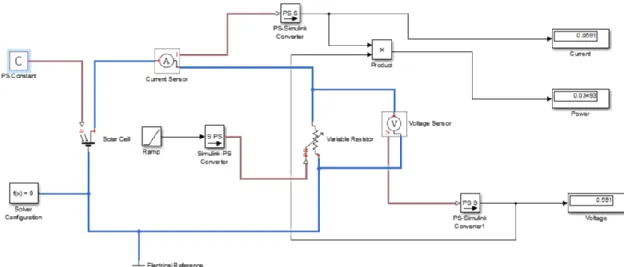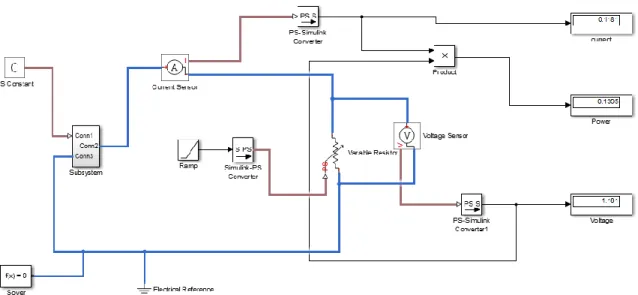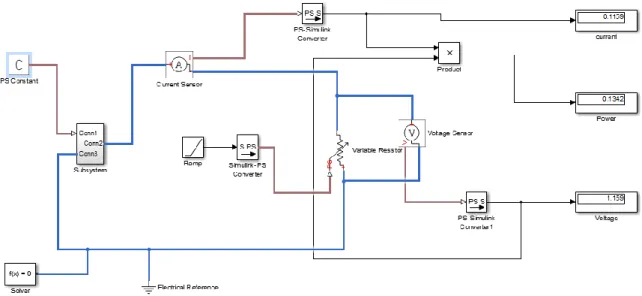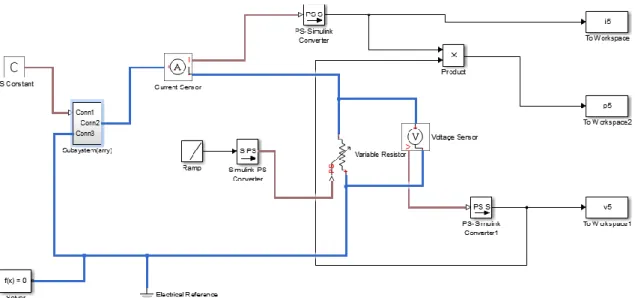In Partial Fulfillment of the Application for the Bachelor of Science Degree in Electrical and Electronics Engineering. This is to certify that this project and thesis titled “Study of Energy Extraction Characteristics of Solar Photovoltaic Cells, Modules and Arrays Using Lab Mat” was done by the following students under my direct supervision and this work was done by them in the laboratories of the Department of Electrical and Electronic Engineering at the Faculty of Engineering of Daffodil International University in partial fulfillment of the requirements for the degree of Bachelor of Science in Electrical and Electronic Engineering. This thesis titled "Study of Energy Extraction Characteristics of Solar Photovoltaic Cells, Modules and Arrays Using Mat Lab" submitted by Rayhanul Islam and Md.
Ali Mortuja at the Department of Electrical and Electronic Engineering, Daffodil International University, has been found satisfactory and accepted in partial fulfillment of the requirement for the degree of Bachelor of Science in Electrical and Electronic Engineering.
ABSTRACT
Introduction
- Introduction
- The Photovoltaic Effect 1.3 Objective
- Scope Of The Research 1.5 Thesis Outline
- The Photovoltaic Effect
- Scope of the research
- Thesis Outline
With Albert Einstein's 1905 explanation of the photoelectric effect - metal is essentially absorbed by light and will retain that imperativeness until a ton of light hits it -. Free electrons travel through the material and current flows when the conductors are connected to both sides of the cell. Albert Einstein's careful determination of the photovoltaic effect in 1905 was an essential landmark in the progress of solar-based energy, however, it took until the 1950s for a real one.
Different viewpoints, for example specialized, money-related and social parts of the subject, are considered additional concerns for the report.
LITERATURE REVIEWS
- Solar Cell
- Classification of Solar Cell 2.3 Materials
- Crystalline silicon 2.3.2 Thin film
- Multi junction solar cells 2.4 Solar Energy
- Solar panel working Principle 2.6 Solar really working
- Solar Inverters 2.7 Efficiency
- The Future of Solar cell
- Solar system future in Bangladesh
- Introduction
- Solar Cell, Modules and Array
- Classification of Solar Cell
- Materials
Individual solar devices can be joined together to form modules, also called solar panels. Module: A solar photovoltaic module is a unit photovoltaic panel that is an assembly of interconnected solar cells. Solar-based cells can be made of only one single layer of light-retaining material (single junction) or use distinctive physical plans (multi-convergences) to exploit diverse.
The first cells—similarly called common, common, or wafer-based cells—were made from crystalline silicon, the predominant monetary PV development consolidating materials, for example, poly-silicon and monocrystalline silicon.
Mono crystalline silicon
Second-period cells are graceful, daylight-based cells that contain shapeless silicon, CdTe, and CIGS cells and are mechanically great in utility-scale photovoltaic power plants, composite photovoltaic buildings, or in the minimum free energy system. The third period of solar-based cells joins several small films depicted as emerging photovoltaic cells as often as possible. Most of them are not yet modern associated and are still under research or improvement. Regardless of how their efficiency was low and the strength of the protected material was routinely absurdly short for business applications, a lot of research has gone into these advancements as they guarantee that the goal of making convenience, high quality, is achieved . solar viability.
By far the most common bulk material for solar cells is crystalline silicon (c-Si), also known as "solar-grade silicon" Bulk silicon is divided into numerous categories according to crystallinity and crystal size in rod, strip or the resulting wafer. .
Epitaxial silicon advancement
Polycrystalline silicon
Ribbon Silicon
Mono-like-multi silicon (Ml_M)
Thin film Thin film solar cell
Cadmium Telluride
Copper indium gallium selenide solar cell
Silicon thin film cell
Gallium arsenide thin film
Multi-junction solar cells
Multi-junction cells are the arrangement of multiple thin films interconnected. Each is essentially a solar cell grown on top of another, typically using metal-organic vapor phase epitaxy. Each layer has a different band gap energy to allow it to absorb electromagnetic radiation over a different portion of the spectrum. Multi-junction cells were initially produced for unusual applications, for example, satellites and space exploration, but are now gradually being used in ground-based concentrator photovoltaics (CPV), a growing innovation that uses focal points and bent mirrors to focus daylight onto small, exceptionally skilled multi-junction sunlight. -based cells.
GaInP/Si dual-junction solar cells
- Solar Energy
- Solar panels working principle
- Solar Really Working
- Solar Panels
- Solar Inverters
- Efficiency
- The Future of Solar Cells
- Summary
- IV Curve
- Mat lab Simulation for Solar PV Cell, Module and Array .1 Mat lab Simulation for Single Solar Cells
- Mat lab Simulation for Double Solar Cells 3.4.3 Mat lab Simulation for Solar Array
- Introduction
- Construction of solar cell
- PN JUNCTION
- Mat lab Simulation for Solar Photovoltaic Cells, Modules and Arrays
- Mat lab Simulation for Single Solar Cell
Light (photons) striking certain compounds, especially metals, causes the surface of the material to emit electrons. A useful feature of solar cell production is that any scale of the installation is possible. The most important solar cells were prepared to take 6% of the imperativeness from the sun and transform it into a power of 20W in 1954.
Then, in 2012, the first solar cells were suitable to extract 15% of the essence from the sun and convert it to 200 W. Finally, in 2018, the key solar cells were suitable to extract 18.7% of the essence from the sun and convert it to 320 W [15] . Until then, conductive plates of metal on the sides of the cells collect electrons and move them through the wires.
Although there are different segments that choose the electrical yield of solar-controlled power structure, the amount of solar-based cells and for the most part size of the solar-based charging array are the notable determinants in how much power can be delivered from a nearby power planetary framework. Solar PV system would be useless without solar powered inverters - in that capacity many consider solar based inverters as the "brains" of the whole framework. Usually, sunlight-based converters are about 95% efficient, so they only lose about 5% of the power during the transformation procedure.
In the future, I believe that the use of the narrow planetary system is progressively recognized. Currently, sustainable energy source is one of the parts of our agreement and administration plant. PV cell standard and designation and significant characteristics of PV cells are discussed in area 2.
In the segment 3 numerical model of the ideal PV cell and the rational PV cell.
Numerical Operation for Single Solar Cell
Mat lab Simulation for Double Solar Cell
Numerical Operation for Double Solar Cell Simulation
Matlab Simulation For Photovoltic Solar Array
Numerical Operation for Solar Array
Mat lab Simulation for Solar Panel
Numerical Operation for Solar Panel
Summary
Since the field tests can be expensive and fundamentally depend on the atmospheric conditions, it is profitable to have reenactment models to engage work at any time. Thus, in this paper, the improvement of two photovoltaic display systems has been analyzed. The point of the model is to obtain an IV curve like the outline that presents the manufacturer's data sheet for the tan board.
The models created are almost identical and depending on the required results of the models created, despite being fundamental models, it is possible to consider the lead of photovoltaics in the time domain. Tolerating the authenticity of the two models shows that it is less difficult to make changes according to the main model than in the subsequent model, because it uses data provided by the manufacturer. In the resulting model there is a progressively undeniable number of assumptions, which Iph clearly considers, for example, in the ISC given by the producer.
RESULT AND DISCUSSION
- Numerical Analysis Result of Solar Cell Module And Array 4.3 The Future of Solar Cell
- Advantage Of Solar Cell 4.5 Disadvantage Of Solar Cell
- Introduction
- Numerical Result of Solar PV Cell, Modules and Array
- The Future of Solar Cells
- Advantage of Solar Energy
- Sustainable power Source
- Diminishes Electricity Bills
- Assorted Applications
- Low Maintenance Costs
- Innovation Development
- Disadvantage of Solar Energy
- Cost
- Climate Dependent
- Sun based Energy Storage Is Expensive
- Uses a Lot of Space
- Related with Pollution
- Contamination and vitality underway
- Summary
Using these basic models gives enough accuracy to see the direct direction of the solar cell and has shown to be robust in general. The amount we get a good deal on our bill will depend on the size of the nearby planetary framework and our capacity or use of warmth. In this way, in the wake of managing relatives' covered expenses through planetary social events, we can expect almost no expenses for assistance and arrangement work.
Advances in quantum materials science and nanotechnology could widen the common sense of sunshine-based skins and double, or even triple, the electrical responsibility of the solar-controlled power frameworks. Although sun-arranged essentials can even now be composed during cloudy and swirling days, the ability of the nearby planetary collection drops. That's not too bad a reaction for using solar-powered essentials for the duration of the day, but it's furthermore expensive in every way.
A significant portion of the time, it is progressively smart to just use the solar imperative during the day and take the essentials from the structure during the night (we can do this if our system is related to the grid). One option is to introduce part of the boards into our yard, but they need access to daylight. In the event that we don't have room for all the boards we needed, we can settle for introducing less to currently meet a portion of our vitality needs.
Despite the fact that contamination identified with solar-powered vitality frameworks is much less contrasted with different sources of vitality, solar-powered vitality can be related to contamination. Most of the energy produced is the burning of fossil fuels and therefore produces polluting pollutants that cause high environmental pollution, be it air, soil or water.

CONCLUSIONS AND RECOMMENDATIONS
- Conclusion
- Recommendation
- Conclusions
- Recommendations
The consequences of examining vitality needs for inexhaustible power generation innovations in the close planetary system are exposed. The vast majority of the general population is white-collared, and nearby planetary groups represent the least capital expenditure. We have found from the review of the family unit that trivial advantages and more exercises are advanced by using the nearby planetary group.
Sunlight based light is mostly used for lighting family units, running TV, mobile phone battery charging and radio and so on. Additionally, due to the absence of information and legitimate preparation, these applications have not flourished to astonishing degrees. In the summary, we see that the majority of the shopper believes that its misuse of cash.
In our proposal, when the buyer meanwhile introduces a tight planetary system, if the administration that gives canning, I think it is gradually qualified. Then the buyer knows how to maintain the nearby planetary group, how to properly use the power in profitable work. What's more, we see that the fractional cost of a nearby planetary group is the main measure of money, which is the reason that many buyers would rather not build their own nearby planetary system.
So our suggestion is if the government gives any pile without enthusiasm to introduce the nearby planetary group. We see that after introducing the nearby planetary group, the administration does not take any suitable news about the close planetary system.





![Figure 3.40(a): V-I Characteristics of Photovoltaic Solar Panel When 40% Shade [Irradiation(𝑤𝑚 −2 )-600, 1000] Simulation](https://thumb-ap.123doks.com/thumbv2/filepdfnet/10935641.0/66.893.168.786.105.466/figure-characteristics-photovoltaic-solar-panel-irradiation-𝑤𝑚-simulation.webp)
![Fig- 3.41(a): V-I Characteristics of Photovoltaic Solar Panel When 50% Shade [Irradiation(𝑤𝑚 −2 )-500, 1000] Simulation](https://thumb-ap.123doks.com/thumbv2/filepdfnet/10935641.0/67.893.179.764.108.478/characteristics-photovoltaic-solar-panel-shade-irradiation-𝑤𝑚-simulation.webp)

